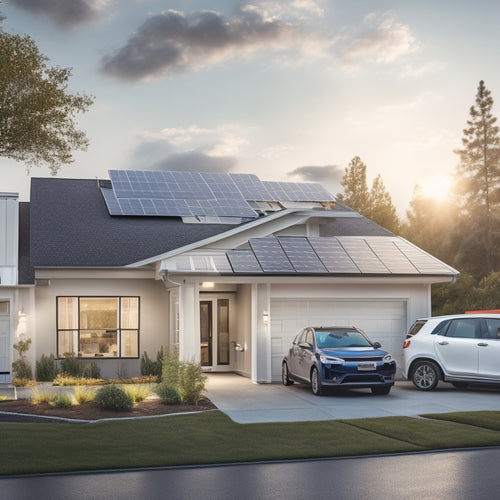
Maximizing Renewable Energy With 7 Storage Solutions
Share
By incorporating the right energy storage solutions, you can maximize renewable energy output, increasing energy independence by up to 80% and reducing greenhouse gas emissions by as much as 70%. To achieve this, consider advanced battery management systems, grid-tied energy storage solutions, and peak shaving and load shifting strategies. Solar-plus-storage system integration, energy storage for microgrids, flow battery energy storage, and intelligent energy management platforms are also key solutions to explore. By evaluating these options, you can optimize your renewable energy system and take a significant step towards a more sustainable future - and there's more to discover about these innovative solutions.
Key Takeaways
• Advanced battery management systems ensure efficient and reliable energy storage by monitoring critical parameters like state of charge, voltage, and temperature.
• Grid-tied energy storage solutions reduce peak demand charges, stabilize the grid, and provide power reliability, making them suitable for utility-scale systems and residential energy backup.
• Peak shaving, load shifting, and energy arbitrage optimize energy distribution and consumption, reducing strain on the electrical grid during high energy demand periods.
• Solar-plus-storage system integration maximizes energy output by selecting a storage system that complements the solar array, using energy forecasting techniques and power optimization algorithms.
• Innovative energy storage solutions like flow battery energy storage and intelligent energy management platforms enhance efficiency, security, and transparency in renewable energy systems.
Advanced Battery Management Systems
Advanced battery management systems (BMS) play an essential role in maximizing the performance, safety, and lifespan of renewable energy storage solutions by monitoring and controlling critical parameters such as state of charge, voltage, and temperature.
As you explore the world of renewable energy storage, you'll find that a reliable BMS is necessary for ensuring the overall efficiency and reliability of your system.
One critical function of a BMS is cell balancing, which involves regulating the charging and discharging of individual cells to prevent overcharging or undercharging. This is important, as unbalanced cells can lead to reduced performance, decreased lifespan, and even safety hazards.
Additionally, thermal monitoring is another crucial component of a BMS, as it helps to detect and prevent overheating, which can lead to system failure.
Grid-Tied Energy Storage Solutions
As you explore grid-tied energy storage solutions, you'll find that they can be categorized into two main types: utility-scale systems and residential energy backup systems.
Utility-scale systems are designed to provide energy storage at a massive scale, often in conjunction with renewable energy sources like solar or wind farms.
Meanwhile, residential energy backup systems are designed to provide backup power to individual homes during outages or grid failures.
Utility Scale Systems
Moreover, you can greatly reduce peak demand charges and stabilize the grid by deploying utility-scale energy storage systems that integrate seamlessly with existing infrastructure. These systems are designed to provide power reliability and grid resilience, ensuring that the lights stay on even during periods of high demand or when the grid is under stress.
By storing excess energy generated during off-peak hours, utility-scale systems can release it when needed, reducing strain on the grid and preventing brownouts or blackouts. This not only benefits the grid but also helps you optimize your energy usage and reduce costs.
With advanced monitoring and control systems, you can track performance, predict energy demand, and adjust storage levels accordingly. Moreover, utility-scale energy storage systems can be easily scaled up or down to meet changing energy needs, making them an ideal solution for large-scale renewable energy projects.
Residential Energy Backup
In residential settings, grid-tied energy storage solutions provide homeowners like you with a reliable backup power source, seamlessly integrating with your existing grid connection to guarantee uninterrupted electricity supply during outages or grid disturbances. This means you can enjoy the comforts of modern living without interruptions, even when the grid goes down.
With residential energy backup, you can rest assured that your home will remain powered, keeping your family safe and comfortable.
Here are just a few benefits of residential energy backup:
-
Peace of Mind: Stay connected with loved ones and access critical information during outages with reliable emergency power.
-
Home Automation: Seamlessly integrate your energy storage system with your home automation system for a more comfortable and convenient living experience.
-
Reduced Downtime: Minimize disruptions to your daily routine with a reliable backup power source that kicks in instantly.
- Increased Property Value: Boost your property value with a state-of-the-art energy storage system that provides a unique selling point for potential buyers.
Peak Shaving and Load Shifting
By implementing peak shaving and load shifting strategies, utilities and grid operators can reduce the strain on the electrical grid during periods of high energy demand, effectively mitigating brownouts and blackouts. You'll be able to optimize energy distribution and consumption, guaranteeing a more reliable and efficient grid.
Peak shaving involves reducing energy consumption during peak hours, while load shifting involves shifting non-essential loads to off-peak hours. By doing so, you'll reduce the strain on the grid and minimize the likelihood of outages.
Energy arbitrage is another benefit of peak shaving and load shifting. By storing excess energy during off-peak hours and releasing it during peak hours, you can take advantage of price differences and reduce your energy costs. Additionally, demand response programs allow utilities to incentivize consumers to reduce energy consumption during peak hours, further reducing the strain on the grid.
Solar-Plus-Storage System Integration
As you design a solar-plus-storage system, you'll need to take into account several key factors to guarantee peak performance.
You'll want to maximize energy output by selecting a storage system that complements your solar array's energy production profile.
System Design Considerations
When designing a solar-plus-storage system, you must carefully consider the integration of both components to guarantee smooth operation and peak performance. A well-designed system assures that the solar panels and energy storage units work harmoniously, maximizing energy output and reducing grid dependence.
To achieve this, consider the following key system design considerations:
-
Thermal dynamics: Assure that your system is designed to handle thermal fluctuations, which can affect the performance and lifespan of your energy storage units.
-
Electrical harmonics: Minimize electrical harmonics to prevent interference with the grid and ensure a stable power supply.
-
System monitoring and control: Implement a monitoring and control system that can detect and respond to changes in energy demand and supply.
- Scalability and flexibility: Design your system to be scalable and flexible, allowing for easy upgrades and modifications as your energy needs evolve.
Optimizing Energy Output
You can greatly increase your energy output by integrating solar panels with energy storage systems, allowing you to harness and utilize more of the sun's energy throughout the day.
This integration enables you to optimize your energy output by storing excess energy generated during the day for use during periods of low sunlight or at night.
By leveraging advanced energy forecasting techniques, you can accurately predict energy demand and adjust your energy output accordingly. This guarantees that you're producing the right amount of energy at the right time, reducing waste and maximizing your return on investment.
Power optimization algorithms can also be employed to fine-tune your energy output, taking into account factors like weather patterns, energy demand, and grid stability.
Energy Storage for Microgrids
Microgrids, which are small-scale, local energy systems, depend extensively on energy storage solutions to guarantee a stable and efficient supply of power. As you explore ways to maximize renewable energy, you'll find that energy storage plays an essential role in ensuring microgrid resilience.
By incorporating energy storage solutions, microgrids can operate in 'islanding' mode, disconnecting from the main grid during outages or disturbances, and continuing to provide power to local communities.
Here are some key benefits of energy storage for microgrids:
-
Enhanced reliability: Energy storage ensures a stable power supply, even when the main grid is down.
-
Improved efficiency: By storing excess energy generated by local renewable sources, microgrids can reduce waste and optimize energy usage.
-
Increased autonomy: With energy storage, microgrids can operate independently, providing power to local communities even when the main grid is unavailable.
- Reduced emissions: By leveraging local renewable energy sources and storing excess energy, microgrids can minimize their carbon footprint.
Flow Battery Energy Storage
Flow battery energy storage, an innovative solution for microgrids, enables the efficient storage of excess energy generated by local renewable sources. As you consider this technology, you'll want to understand how it works.
In essence, flow batteries store energy in a liquid electrolyte solution in external tanks, which are pumped through a membrane to generate electricity. This design allows for flexibility in scaling energy storage capacity, making it suitable for microgrids.
When evaluating flow battery energy storage, you should consider factors like flow dynamics, which affect the overall efficiency of the system. The flow rate, pressure, and velocity of the electrolyte solution all impact the reaction kinetics and, ultimately, the performance of the battery.
Moreover, electrolyte stability is critical, as it affects the battery's lifespan and overall reliability. By understanding these technical aspects, you can make informed decisions about implementing flow battery energy storage in your microgrid project.
With the right design and implementation, flow batteries can provide a reliable and efficient means of storing renewable energy.
Intelligent Energy Management Platforms
Intelligent energy management platforms orchestrate the intricate interplay between renewable energy sources, energy storage systems, and power distribution networks, enabling real-time monitoring and optimization of energy flows.
As you navigate the shift to renewable energy, you need a system that can integrate and manage the various components of your energy infrastructure. That's where intelligent energy management platforms come in. These platforms leverage advanced data analytics to provide you with actionable insights into your energy usage and storage needs.
Here are just a few benefits you can expect from intelligent energy management platforms:
-
Enhanced Efficiency: Optimize energy distribution and reduce waste with real-time monitoring and predictive analytics.
-
Improved Security: Implement robust cybersecurity measures to protect your energy infrastructure from cyber threats.
-
Increased Transparency: Gain visibility into your energy usage patterns and make data-driven decisions.
- Scalability: Seamlessly integrate new energy sources and storage systems as your infrastructure grows.
Frequently Asked Questions
Can Energy Storage Systems Be Used for Both Residential and Commercial Purposes?
You can utilize energy storage systems for both residential and commercial purposes, achieving grid parity and optimizing load shifting to reduce peak demand, while increasing energy independence and cost savings.
How Long Does It Take to Install a Renewable Energy Storage System?
As you envision a smooth shift to renewable energy, you wonder how long it'll take to install your system. The installation timeline typically spans 2-5 days, but factor in 2-6 weeks for the permitting process, and you'll be harnessing clean energy in no time.
Are Energy Storage Systems Compatible With Existing Renewable Energy Infrastructure?
You'll be relieved to know that energy storage systems are designed to be compatible with existing renewable energy infrastructure, ensuring seamless grid integration and system interoperability, allowing you to efficiently harness renewable energy.
Can Energy Storage Systems Provide Backup Power During Outages?
"You'll be surprised to know that 1 in 5 power outages lasts over 24 hours! Fortunately, energy storage systems can provide backup power during outages, enhancing grid resilience and power reliability, ensuring you stay connected when you need it most."
Are There Any Government Incentives for Investing in Energy Storage Systems?
You'll be pleased to know that, yes, government incentives abound for investing in energy storage systems, including lucrative Tax Credits and competitive Green Grants, encouraging you to join the sustainable energy revolution.
Related Posts
-

What Electric Vehicle Owners Need for Home Energy
As an electric vehicle owner, you need to optimize your home energy system to guarantee efficient, sustainable, and c...
-

Charging Points in Rural Areas: 5 Key Insights
When driving through rural areas, you'll face a shortage of charging points, making EV ownership stressful and inconv...
-

Safety First: Why Seniors Need Advanced Vehicle Features
As you get behind the wheel, you're likely unaware that seniors are 16% more likely to be involved in a fatal car cra...


